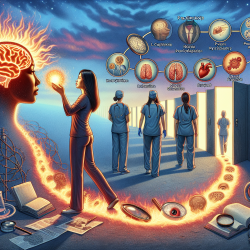Igniting Passion in Psychiatry: A Pathway to Change
In a world where mental health needs are rapidly increasing, the shortage of psychiatrists poses a significant challenge. The study titled Factors Affecting Recruitment into Psychiatry: a Canadian Experience sheds light on how medical education can play a crucial role in addressing this issue. The research highlights the importance of pre-clerkship exposure in influencing medical students' choice of psychiatry as a career. This blog explores the implications of these findings and how practitioners can enhance their skills and contribute to a brighter future for mental health care.
The Power of Early Exposure
The study conducted by the Canadian Organization of Undergraduate Psychiatry Educators (COUPE) reveals a significant relationship between the duration of pre-clerkship exposure to psychiatry and the likelihood of students choosing psychiatry as their first-choice discipline. The research indicates that increasing the weeks of pre-clerkship exposure can lead to a higher enrollment of medical students into psychiatry residency programs.
Data-driven decisions are at the heart of improving recruitment into psychiatry. The study found that medical students were exposed to an average of 2.8 weeks of pre-clerkship psychiatry, and this exposure was a strong predictor of their interest in pursuing psychiatry. This insight suggests that medical schools should consider extending pre-clerkship exposure to inspire more students to enter this critical field.
Implications for Practitioners and Educators
For practitioners and educators, these findings offer a roadmap to enhancing recruitment into psychiatry. Here are some actionable steps:
- Enhance Pre-clerkship Programs: Extend the duration and quality of pre-clerkship exposure to psychiatry. This can include interactive sessions, patient interactions, and exposure to various psychiatric subspecialties.
- Mentorship and Role Models: Encourage psychiatrists to mentor medical students, providing them with insights into the rewarding aspects of the profession.
- Address Stigma: Incorporate discussions on the stigma surrounding mental health and psychiatry into the curriculum to foster a more positive perception of the field.
- Innovative Teaching Methods: Utilize case-based learning, problem-based learning, and e-learning modules to engage students and enhance their understanding of psychiatry.
Encouraging Further Research
While this study provides valuable insights, it also opens the door for further research. Practitioners and educators are encouraged to explore additional factors that may influence medical students' career choices, such as the timing of exposure and the impact of different teaching methods. By continuing to investigate these areas, we can develop more effective strategies to attract future psychiatrists.
Conclusion
As the demand for mental health services continues to rise, addressing the shortage of psychiatrists is more critical than ever. By increasing pre-clerkship exposure to psychiatry and implementing the findings of this study, we can inspire a new generation of medical students to choose this vital field. Together, we can create a future where mental health care is accessible to all who need it.
To read the original research paper, please follow this link: Factors Affecting Recruitment into Psychiatry: a Canadian Experience.










